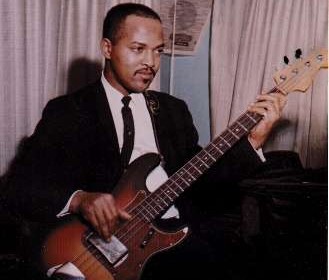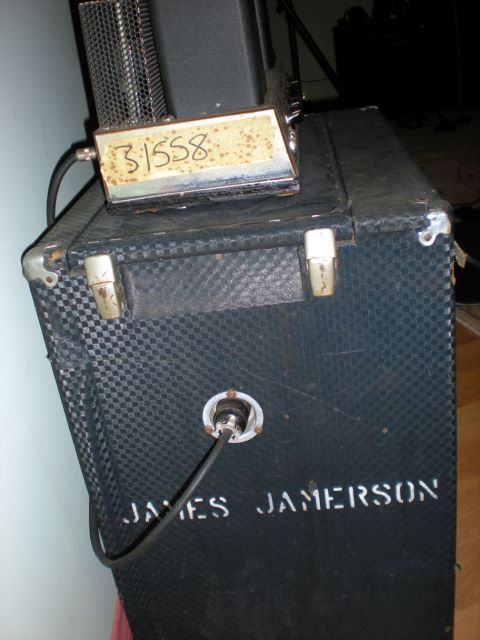 In August 1999, James Jamerson was inducted into the Rock And Roll Hall Of Fame for his legendary bass line artistry in contributing to Motown Records’ endless hit record successes in the music evolution of the 60’s.
In August 1999, James Jamerson was inducted into the Rock And Roll Hall Of Fame for his legendary bass line artistry in contributing to Motown Records’ endless hit record successes in the music evolution of the 60’s.
As a child growing up in Youngstown Ohio, my entire mind and life seemed revolved in and around some form of music. I loved the warm sound of my viola in the 4th & 5th grades after piano lessons in the 3rd grade and ended my teen years as a trumpet player and also enjoyed singing bass in a singing group. In college, I was an intricate part of a well traveled brass ensemble playing the baritone horn. The point of this brief history about me basically shows that from age 9 to age 20, I gradually edged, without knowing it, closer and closer to the feel, sound and rhythm of music in the bass clef – the instrument of my choice was the new electric bass instrument AKA and referred to as a ‘Fender’.
When speaking and/or writing about that ‘day in time’ (the 60’s musical revelations), James Jamerson and Pop music are as synonymous to music legend as Little Richard & Chuck Berry are to Rock n Roll, and as are The 5 Keys & The Moonglows are to doo-wop singing. I could go on, but I must elaborate on Jamerson.
 As the 60’s music scene arrived, the original style and sound of the electric bass had already been pre-empted and made famous or at least interesting in jazz by Monk Montgomery and Muscles Swanston. Rock artist such as Bill Haley & The Comets and the smooth/pop music by groups such as The Flamingos were seen with the instrument. Keep in mind that the early 60’s were still showing a heavy 50’s music concept that ultimately changed quickly as Berry Gordy’s Motown Record Company in Detroit began to achieve multi-chart space with hit record after hit record …Jamerson after Jamerson!
As the 60’s music scene arrived, the original style and sound of the electric bass had already been pre-empted and made famous or at least interesting in jazz by Monk Montgomery and Muscles Swanston. Rock artist such as Bill Haley & The Comets and the smooth/pop music by groups such as The Flamingos were seen with the instrument. Keep in mind that the early 60’s were still showing a heavy 50’s music concept that ultimately changed quickly as Berry Gordy’s Motown Record Company in Detroit began to achieve multi-chart space with hit record after hit record …Jamerson after Jamerson!
Ever wonder what the specific ingredient of a hit record was or is? If you are a producer, writer, arranger, artist, an avid fan of the artist or a listener – you might consider first – the groove, sound and feel of the bass instrument and who is playing it. True, The 4 Tops, Stevie Wonder, The Supremes, Mary Wells, Smokey Robinson, The Temptations and Jr. Walker were indeed very special and talented artists, but consider three things; (1) all the songs were good songs, (2) all the horn and string arrangements were great and (3) all songs and arrangements were led by the bass part. All but a few bass parts were played by my hero James Jamerson.
I did not observe until the mid 70’s, record companies giving credit to the unsung heroes (sidemen) on record projects. Some unique history may be lost, but for us musicians, we have more than memories – we have ears! You can hear the difference between Clifford Brown and any other trumpet player and the same is true for Jimmy Hendrix’ Guitar style or King Curtis tenor sax style. Having ears is the stepping stone to feeling what is heard or if your a player, having a feeling is like a smile or a laugh that is synonymous to you. Next is the sound of a player- put ears, feel and sound together and it designates the individual (like a finger print). All this points to one James Jamerson, one DNA and one fingerprint.
Motown’s history and success is chronicled over and over by those who were there with him at the time of the actual recordings, those who have successful listening and or hearing skills and those with an ability to hear the difference between the sound, style and feel of different players. I applaud and I am proud to be a part of Allan Slutsky’s efforts in his documentary of the life and music of James Jamerson entitled STANDING IN THE SHADOWS OF MOTOWN – JAMES JAMERSON distributed by Hal Leonard Publishing. Here Motown artist, producers and fellow musicians give recorded comments in honoring him and 29 of the most influential and successful electric bassists give recorded comments and perform Jamerson’s original Motown bass lines.
The 60’s were very tough for the so-called professional bassist who chose to play the electric instrument. In New York, and I imagine in most other places, a lot of prominent bassists negated the instrument along with those musicians who were playing it. It has come to past that in reality, some of those that did bother to make negative comments never learned to play the electric instrument while some of them did learn how to function with it and subsided their negative comments. Once any bassist heard or hears Jamerson play the electric bass instrument, an immediate respect for him and the instrument occurs.
I am proud to say that I came through that 60’s era with flying colors and Jamerson had a lot to do with my prevailing thoughts and habits regarding the new sound(s) and feels that were unfolding in the music industry. Although James was an acoustic bass player first, he opened the career door for the rest of us electric players basically by being heard so many times on radio hits produced by Detroit Motown. When I herd Bernadette by the 4 Tops in the 60’s, my heart throbbed for a week. I Was Made To Love Her by Stevie Wonder during that same time period caused another week of sheer electric bass ecstasy.
After moving to LA in the early 70’s, You can imagine how thrilling it was to join other studio bassist in periodically going over to the new Motown Studios and playing most of my favorite Jamerson bass parts on either artist roster remakes of the original hits or instrumental versions of the same. Since most or all of the Motown hits were led by the bass line, orchestrators made sure that the original bass parts were noted and in having the ability to read the part – one surely would see it as a treasure and something to remember.
The following list of bass players, artist and producers have recognized and collectively honored James Jamerson’s contribution to their careers and to organized music by participating in Dr. Licks STANDING IN THE SHADOWS OF MOTOWN – JAMES JAMERSON: James Jamerson Jr., Paul McCartney, Anthony Jackson, Basil Fearrington, Jimmy Haslip, Pino Palladino, Bob Babbitt, Marcus Miller, Smokey Robinson, Gerald Veasley, Stevie Wonder, Chuck Rainey, John Patitucci, Phil Chen, Will Lee, Allen McGrier, Willie Weeks, Gary Talent, John Entwistle, The Funk Brothers, Freddy Washington, Nathan Watts, Geddy Lee, Rocco Prestia, Jack Bruce, Brian & Eddie Holland, Kenny Aaronson, David Hungate and The Philadelphia International Rhythm Section – forward by Berry Gordy / Motown Founder. You will find so much more literary sources of his legacy in STANDING IN THE SHADOWS OF MOTOWN – JAMES JAMERSON.
Jamerson moved to LA in the mid 70’s as did so many others at that time. Motown however, was again on the move with new artist added to the label and in an environment that was very different from Detroit. In Detroit everyone lived about the same and close to one another. The LA (Hollywood) life style invites and creates environmental distance and competition. Having helped to make Motown and its Detroit artist rich and successful, Jamerson found himself in a much larger musical environment where the Competition that he created earlier in Detroit now ruled. Some say the change in music and bass styles caused him problems in working a lot, and some say that he was just set in his way and it came off as ‘old fashioned’.
I tend to feel that he was just ‘set in his ways’ about people and the music. LA people and their environments certainly are not at all like Detroit, and for sure their is a certain amount of environmental shock to be experienced and expected during the first year(s) of an environmental move. Some fare well with it and some do not. Of what I saw and what little I knew of him personally, he was very proud of himself and was out spoken in conversations about music and in the music. I am very proud of myself and I can be out spoken in conversations about music and in the music, but I do not believe that I would have my energy and zeal for the electric bass without the life and success of James Jamerson.
-Chuck